Clinetix
[63 miles from Denhead, Fife]
Our medical professionals use their years of experience with aesthetic patients to advise our clients on the best solutions.[READ MORE]
Clinetix Glasgow City Centre, 6th Floor, 14 Mitchell Lane, Glasgow, G1 3NU

We are sorry but we currently do not have any Fractional Laser Skin Resurfacing clinics in your area.
We have listed below the nearest clinics to Denhead, Fife.
[63 miles from Denhead, Fife]
Our medical professionals use their years of experience with aesthetic patients to advise our clients on the best solutions.[READ MORE]
Clinetix Glasgow City Centre, 6th Floor, 14 Mitchell Lane, Glasgow, G1 3NU
[96 miles from Denhead, Fife]
Unique Skin offers a range of professional medical aesthetic treatments by a registered Nurse. Any age or any gender treated. Clinics in Thurso, Fort William, Orkney and The Isle of Skye. [READ MORE]
The Cherries, Kintessack, Forres, IV36 2TG
[112 miles from Denhead, Fife]
Orchid Aesthetics is an Award winning cliinic Sharon is a nurse prescriber and Key Opinion Leader (KoL) and trainer for Hansbiomed MINT PDO threads Sharon works between Sunderland and Ha...[READ MORE]
40 Sea Road, Sunderland, SR6 9BX
[169 miles from Denhead, Fife]
Skincare Is Our Passion Our Clinic Team are experts in their field, maintaining the highest standards of care. We are obsessed with education and are on a mission to share our passion with you.[READ MORE]
Beyond Skin Clinic, 14 College Street, Belfast, BT1 6BT
[170 miles from Denhead, Fife]
At Woodford Medical we are a professional and trusted partnership who have worked in the aesthetic and cosmetic industry since 1995. What distinguishes us here at Woodford Medical is that we aim ...[READ MORE]
Suite 1b, 1st Floor, Marlborough House, 348 Lisburn Road, Belfast, BT9 6GH
[170 miles from Denhead, Fife]
RejuvaMed Health & Wellness offers medical cosmetic & skincare treatments led by Consultant Doctor, Grant McKeating, vascular treatments with Mr Vittorio Perricone, women's health services with Dr H...[READ MORE]
Holmes Cottage, Woone Lane, Clitheroe, BB7 1BG
[175 miles from Denhead, Fife]
Discover Laser is an established Medical Aesthetic Skin Clinic in Burnley, Lancashire. Medical Director Dr Miguel Montero and Consultant Dermatologist and Mohs Surgeon Dr Arif Aslam, lead a team of ...[READ MORE]
Crow Wood Leisure, Royle Lane, Burnley, BB12 0RT
[176 miles from Denhead, Fife]
Here at Surface we offer a high level of expertise and customer care to enable us to advise on medical grade evidence-based treatments. We are based in the World Heritage Site of Saltaire and are ...[READ MORE]
51 Bingley Road, Saltaire, Bradford, BD18 4SB
[179 miles from Denhead, Fife]
Aesthetic Health is led by Dr Julia Sevi who is respected on the world stage for her pioneering approach to medical aesthetics which combines the latest science with regenerative medicine and holistic[READ MORE]
305 Harrogate Road, Leeds, LS17 6PA
[181 miles from Denhead, Fife]
Led by our founder Emma Chan, we are an exclusive medical aesthetics company offering a revolutionary approach to skin perfection. We believe it is really important that people feel good about thems...[READ MORE]
10 Matrix Point, Matrix Way, Buckshaw Village, PR7 7ND
[186 miles from Denhead, Fife]
A pioneering, nurse led aesthetics clinic Established over 10 years underpinned by high quality, patient centred care & exemplary aftercare.[READ MORE]
34 Market Place, Heckmonwike, West Yorkshire, WF16 0JG
[187 miles from Denhead, Fife]
Located near Leeds, Face the Future Advanced Skin Clinic for men and women, is an innovative clinic, specialising in the very best advanced treatments for a variety of skin issues, the very latest in...[READ MORE]
141 Newmarket Lane, Stanley, Wakefield, WF3 4BY
[190 miles from Denhead, Fife]
At Alisha Louise Aesthetics, you can expect geniuine care and professionalism. By adopting only the most up to date and safest techniques, every patient can expect to feel relaxed and in safe hand...[READ MORE]
8 Swan Alley, Ormskirk, L39 2EQ
[192 miles from Denhead, Fife]
Mid Yorkshire Skin Clinic is a medical cosmetic clinic. Our nurses Dan and Joanne Nixon both work full time in medical aesthetics and have over 30 years nursing experience. They share the knowledge ...[READ MORE]
70-72 Station Lane, Featherstone, Pontefract, WF7 5BB
[197 miles from Denhead, Fife]
We are experts in Vaser liposuction, laser hair removal, dermal fillers and skin rejuvenation and our main aim is to help you to find confidence in your appearance. As medically qualified and expe...[READ MORE]
20 St Anns Square, Manchester, M2 7HG
[202 miles from Denhead, Fife]
At Matrix Clinicals, with our team of experts including Medical and Cosmetic Consultant, with over 17 years experience, we are able to provide comprehensive care tailored to every individual helpi...[READ MORE]
2 Greek Street, Stockport, SK3 8AB
[203 miles from Denhead, Fife]
At the Lynton Clinic we offer advanced skin treatment for both men and women. Our results in skin rejuvenation, facial tightening and body shaping, anti-ageing and removal of skin problems are truly...[READ MORE]
Unit 9d, Manor Lane, Holmes Chapel, CW4 8AF
[204 miles from Denhead, Fife]
At Re-Enhance Skin and Body Clinic we offer a comprehensive range of treatments. These include non-surgical cosmetic treatments such as anti-wrinkle injections and vein removal through to minor surgi...[READ MORE]
17 Cecil Road, Hale, WA15 9NZ
[205 miles from Denhead, Fife]
At Sarah White Aesthetics we pride ourselves on our highly skilled team and the quality and continued development of the large range of hospital-based aesthetic treatments we offer. We are at the for...[READ MORE]
The Stables, 242 Telegraph Road, Heswall, Wirral, CH60 7SG
[206 miles from Denhead, Fife]
Revitalaser specialises in pain free laser hair removal and also offer electrolysis for permanent hair reduction. We use cosmeceutical skincare products to help treat scars, burns and pigmentation. We...[READ MORE]
182a Telegraph Road, Heswall, Merseyside, CH60 0AJ
[209 miles from Denhead, Fife]
Dr. Nyla Raja is the founder and Medical Director of Medispa Wilmslow and more recently opening clinics in Liverpool and Harley Street London. She is a highly respected and much sought after cosmetic ...[READ MORE]
Castlerock House, Alderley Edge, Cheshire, SK9 7QL
[210 miles from Denhead, Fife]
Rework Skin Clinic uses state of-the-art, NHS approved, Lynton LUMINA® laser equipment to to specialise in offering the best possible results in laser aesthetics, skin rejuvenation and tattoo rem...[READ MORE]
22 Commercial Street, Sheffield City Centre, Sheffield, S1 2AT
[221 miles from Denhead, Fife]
Based in Grimsby, Looks Cosmetic and Laser Clinic offers non-surgical aesthetic treatments and all sort of Laser treatments ,Filler and Antiwrinkle injections to give a non surgical Facelift. ...[READ MORE]
5 East End Close, Grimsby, DN33 2HZ
[221 miles from Denhead, Fife]
Award-Winning Pure Perfection Clinic. Established in 2008 and situated in the heart of Rossett, Pure Perfection Clinic is North Wales’ leading aesthetic treatment center.[READ MORE]
Chester Road, Rossett, Wrexham, LL12 0HW
[225 miles from Denhead, Fife]
Many of us are concerned to some degree about our appearance. At Renew Clinic we believe that everybody has the right to feel good about themselves. Renew Clinic has quickly established itself as one ...[READ MORE]
33a Hospital Street, Nantwich, CW5 5RL
[232 miles from Denhead, Fife]
Lincoln Laser Skincare located in Lincoln specialises in aesthetic laser skin treatments. The clinic is ideally situated to serve the towns of Retford, Gainsborough & Newark. Lincoln Laser Skincare o...[READ MORE]
3 Beaumont Fee, Lincoln, LN1 1UH
[240 miles from Denhead, Fife]
The decision to have any cosmetic procedure is a very personal one. We help you make the right decision for you. The clinic provides cosmetic medical and surgical treatments. The treatments are delive...[READ MORE]
Ground Floor Suite, 2 Vernon Street, Derby, DE1 1FR
[242 miles from Denhead, Fife]
Zenith Cosmetic Clinic offers surgical, non-surgical, dental and cosmetic aesthetic treatments including Weight Loss, Skin, Anti-ageing and Cosmetic Dentistry. They are located in Nottingham and Lond...[READ MORE]
6 Clinton Terrace, Derby Road, Nottingham, NG7 1LY
[246 miles from Denhead, Fife]
The Ailesbury Clinic in Dublin run by Dr Patrick Treacy, and Nurse Lorraine Delaney offer a wide range of cosmetic treatments, including laser skin resurfacing. The clinic is conveniently located on ...[READ MORE]
David Lloyd Riverview, Beech Hill Rd. Clonskeagh, Dublin, DUBLIN 4
[248 miles from Denhead, Fife]
At Dundrum Clinic, it is our policy to offer only PROVEN effective cosmetic treatments for men and women , using the most advanced FDA approved equipment and procedures, delivered by the most skilled ...[READ MORE]
Medical Centre On Level 4, Dundrum Town Centre, Dundrum, DUBLIN 16
Fractional Laser Skin Resurfacing FAQ
The use of light as a medical treatment has grown considerably over the past few years. There are now many kinds of devices, which deliver various different types of light for an ever-increasing number of potential uses.
Ultra - Violet light, for example, has been used to treat psoriasis (a skin disease) for a number of years, and many people use light boxes during the winter to reduce the symptoms of seasonal affective disorder (SAD). Simply, exposure to certain kinds of light often makes people feel better!
The use of light from lasers for medical procedures was developed in the 1960s when they were first used as cutting tools in operations by some surgeons. Laser technology has developed over the last few decades to treat patients with a variety of different skin problems including the effects of sun damage, the removal of body hair and recently the treatment of psoriasis and acne.
Lasers are also commonly used by ophthalmologists (eye specialists) for the treatment of certain eye conditions, and there are also now numerous private clinics offering laser treatment as a solution to short sightedness.
Since the early 1990s, lasers have become the high tech equivalent of dermabrasion or deep chemical peels for skin resurfacing (removal of the outer layer of the skin). Laser skin resurfacing declined in popularity due to the development of less aggressive light treatments aimed at skin rejuvenation.
Figures from the American Society for Aesthetic Plastic Surgery (ASAPS), which started to track statistics for fractional laser skin resurfacing treatments, specifically with the Fraxel™ device from 2007, have now broadened the data gathered to various ablative and non-ablative fractional laser devices. For example, data indicates that in 2019, 66,275 micro-ablative resurfacing treatments were performed, an increase of 71.9% on the number of procedures in 2018. Micro-ablative resurfacing (fractional resurfacing) is now the seventh most popular non-surgical cosmetic procedure in the USA.
If you are considering fractional laser skin resurfacing the following information will give you a basic understanding of the procedure. It can't answer all your questions, since a lot depends on the individual patient and the practitioner. Please ask a practitioner about anything you don't understand.
A laser is a high-energy beam of light that can be directed into certain areas or tissues within the skin. These beams of light are produced in one wavelength or colour at a time, and can vary in terms of their strength and the type of tissue that they can target.
The process of directing a light source to target a selected area of the skin to damage it is technically known as "selective photothermolysis"; where “thermolysis” refers to ‘decomposition by heat’ and “photo” refers to ‘light’.
Ablative Lasers
So - called "ablative" or skin resurfacing lasers briefly direct an intense burst of laser energy onto the surface of the skin. This energy heats water within the surface layers of the skin, causing both the water and the tissue of the skin to turn to vapour. Every time the laser passes over the skin, some of the outermost layers of the skin are removed in a precise and controlled way to the appropriate depth.
The skin then heals over a period of time, as new layers of collagen are produced. The skin can literally resurface itself, causing an improvement in the appearance of sun damaged or acne scarred skin. After the treatment, the skin will look much healthier than it did previously.
This intensive treatment can significantly reduce the appearance of lines, wrinkles, and pigment (or skin colour) changes on the face, neck, and other parts of the body. They can be used in sensitive areas, such as lines around the lips, eyes and even eyelids, or over the whole of the face. Acne and other types of scars and certain stretch marks can also be improved.
There are two main types of ablative laser - the original machines used were carbon dioxide lasers, and more recently erbium:YAG laser systems have been introduced.
Non - Ablative Lasers
The so called non-ablative lasers have been a more recent introduction in types of aesthetic equipment for skin rejuvenation.
These lasers have lower energy levels than ablative lasers (which resurface or remove the outer layer of skin completely), and try to cause damage within the dermal layer of the skin without removal of the outer epidermal layers. That is to say that the laser treats the layers of skin under the surface without damaging the surface too much. This lessens the recovery period after the treatment and reduces the number of complications that can occur.
It is thought that the laser's heat in the dermal layers causes collagen to be produced which helps reduce the appearance of lines and wrinkles. However, the results from this type of procedure are less obvious than those which can be achieved with ablative laser skin resurfacing during which the surface of the skin is removed.
The use of different types of lasers by cosmetic clinics has increased significantly in recent years. The new non-ablative laser machines are aimed at giving maximum treatment results with minimum recovery time after the treatment. More recent still is the arrival of other non-ablative light machines, such as Intense Pulsed Light (IPL), Light Heat Energy (LHE) and Light Emitting Diode (LED) systems that can be more flexible in their use than some other lasers.
Unlike with selective photothermolysis, where the whole of the selected target area is damaged; “Fractional Photothermolysis” seeks to only damage certain zones within the selected target area, (producing tiny dot, or pixel-like treated areas on the skin), leaving the other zones within it perfectly intact; hence only causing fractional damage through the heat of the light source. This allows the skin to heal much faster than if the whole area was treated, as the ‘healthy’ untreated tissue surrounding the treated zones helps to fill in the damaged area with new cells.
Fractional Photothermolysis or Fractional Laser Skin Resurfacing can therefore be compared to the precise alteration of digital photographs that we are able to do nowadays; pixel by pixel.
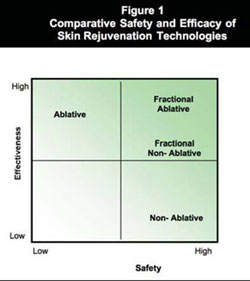
The concept of this fractional laser technology can be applied with either ablative laser resurfacing or non-ablative laser skin rejuvenation, using the various different wavelengths of lasers available. The efficacy and safety of the different types of laser technologies is illustrated in the chart (right); (Source: Aesthetic Buyers Guides, March/April 2007).
This fractional approach (ablative and non-ablative) claims to achieve comparable skin improvements as obtained with conventional ablative laser resurfacing with an Er:YAG or CO2 laser, (depending on depth and severity of wrinkles), but without the associated side effects or downtime; i.e. you get the results of an ablative laser but with the downtime of a non-ablative laser.
Optimal improvement after fractional treatment is usually visible in about 2 - 3 months as collagen remodelling and skin tightening continues. The longevity of results is comparable to ablative laser resurfacing and as always is dependent on future ageing, the effects of gravity and sun exposure.
Initially, when this technology was first introduced in 2003 there was only one device in the UK and US marketplace for fractional photothermolysis, the Fraxel™ SR laser machine by Reliant Technologies Inc (now part of Solta Medical). It subsequently became the first fractional device to be cleared by the US FDA for a variety of other indications, such as the correction of wrinkles around the eyes (2004), skin resurfacing (2005) and the treatment of melasma (2005), pigmented lesions, e.g., freckles, age spots etc. (2004) and acne scarring (2006).
Although the Fraxel™ devices are still used, other manufacturers are rapidly expanding their product ranges in this niche area to meet the growing demand.
The original Fraxel™ laser machine fired a 1550nm diode pumped erbium fibre laser beam which is then split into thousands of microscopic beams, producing tiny dot, or pixel-like treatment zones on the skin; referred to by the manufacturer as MicroThermal Zones (MTZs).
At 1,500 – 2,500 MTZs per cm2 (depending on machine settings), the MTZs are invisible to the naked eye, other than as an overall “bronzed” look they give to the skin. Each MTZ is about 30 - 70 microns in diameter, (a micron is one millionth of a metre), and 400 - 700 microns deep. This is in contrast with the typical depth of 200 - 400 microns achieved with ablative resurfacing; where any deeper and you risk scarring. The Fraxel™ laser treats between 12 - 20% of the skin with each treatment session.
As with ablative lasers, the Fraxel™ is also attracted and absorbed by water in the tissues; however in this case the stratum corneum, (the outermost layer of the skin, consisting of dead cells that slough off) is more or less spared from damage by its low water content, meaning it has a low absorption of laser energy.
The manufacturer, Solta Medical have since replaced their original Fraxel® SR Laser with a range of devices including the Fraxel re:fine, re:store (and re:store dual) and the re:pair.
Launched in the US in April 2006, the FDA approved Pixel® 2940 from Alma Lasers (distributed in the UK by Advanced Beauty Cosmetics Ltd) is a 2940nm Er:YAG ablative laser delivered to the skin through a micro optics lens which creates 49 (7x7) or 81 (9x9) pixel sized ablation dots on the skin within an 11mm x 11mm treatment zone.
Alma Lasers market the Pixel® 2940 as ‘combining the proven effectiveness of an ablative approach with the patient comfort level and convenience of a non-ablative approach’.
Unlike traditional ablative lasers, used only on the face, the Pixel® 2940 is targeted at treatments on the face, neck, chest, arms and hands, giving it a wider scope for treating aged and sun damaged skin.
The Lux 1540™ Fractional device from Palomar (distributed in the UK by Eden Aesthetics) is a 1540nm erbium glass fibre non-ablative laser, which is delivered to the skin in tiny microbeams, in combination with contact cooling of the skin’s surface.
The Lux 1540™ can penetrate up to a depth of 1mm into the skin, whilst also leaving the skin’s surface intact, creating tiny columns of treated (or coagulated) tissue which are surrounded by the healthy tissue. With a choice of treatment size heads for skin resurfacing and wrinkle reduction, the Lux 1540™ can produce 100 microbeams/cm2 columns for deep coagulation (up to 1mm) with a 10mm head, or 320 microbeams/cm2 narrower columns for relatively shallow coagulation, with the 15mm head.
It was approved by the FDA in February 2007 for ‘skin resurfacing procedures and dermatological procedures requiring the coagulation of soft tissue’.
Fractional lasers are a growth area within the laser technology field, with more and more companies entering the marketplace, either with new devices or modifications of existing machines. Some others you may find include:
Affirm™ from Cynosure – This is a 1440nm Nd:Yag non-ablative laser with Cynosure’s proprietary Combined Apex PulseSM (CAP) technology. This is a special lens mounted over the end of the laser that consists of approximately 1,000 diffractive elements per cm2 which put simply ‘bends’ the wavelength of light emitted from the laser so as to affect more surface area per single pulse of the laser. The Affirm™ targets the superficial layers of sun damaged skin, and delivers both a high and low energy of light within the treatment zone, due to the lens configuration, which they claim enhances collagen remodelling whilst also stimulating collagen production.
Active FX from Lumenis – This is based on the company’s existing UltraPulse Encore technology, which underwent computerised modifications, and now comprises a single treatment system for ablative fractional photothermolysis with a CO2 laser. Active FX is the most aggressive of the fractional laser devices introduced to the market so far. As such treatment with this device requires a topical anaesthetic and produces the most lengthy down time for this type of procedure.
Profractional from Sciton - This 2940nm fractional ablative laser device was launched in the US in April 2006 and in the UK in April 2007, (distributed by Sigmacon Ltd). The manufacturers claim that it differs from other fractional devices because of the method of delivery of the laser energy, which it says makes for a more comfortable treatment experience by reducing any unnecessary heat build-up. With a treatment head of 20mm x 20 mm, the Profractional can produce a variety of pattern configurations (dots) on the skin depending on the condition and area being treated. These dots can penetrate from 25 to 1500 microns in depth, depending in the settings used. The Profractional can treat from 1.5% – 60% of the skin within a treatment zone.
Fractional photothermolysis is used for the treatment known as skin rejuvenation/resurfacing, which includes; the reduction and possible removal of fine lines and wrinkles, improvement of deeper wrinkles, repair of sun damaged skin on the face, neck, shoulders and hands, the reduction of age spots and blemishes, acne scars and hyperpigmentation (areas of darker pigment or brown patches in the skin).
The Fraxel™ re:store laser, for example, has been awarded clearance by the American Food and Drug Administration (FDA) for dermatological procedures requiring soft tissue coagulation; for the correction of peri-orbital wrinkles (crow’s feet), acne scarring and pigmented lesions, including age spots, sun spots and skin discolouration; for skin resurfacing and for the treatment of melasma, (dark skin colouration which forms on sun exposed skin – often affects women during pregnancy).
Careful discussions regarding your reasons for wanting treatment are very important before you begin the treatment. You must also make sure that this treatment can deliver what you want and how you would like to look afterwards. Your practitioner should be able to answer all these questions.
A medical history should also be taken to make sure that there are no reasons why you shouldn’t undertake treatment. You may be asked to read detailed information and sign a consent form which means that you have understood the potential benefits and risks associated with the procedure.
Photographs may also be taken by the practitioner for a "before and after" comparison at a later date.
Procedure
The way that the procedure is performed and the preparations involved will depend on the specific device that the practitioner is using. The type of device used will have a bearing on the need for contact gels, cooling systems, topical anaesthetics etc.
As an illustration we will describe the process involved with treatment using the Fraxel™ laser.
The skin is first cleansed and a topical local anaesthesia may also be applied to increase patient comfort during the procedure, the handpiece also has a built in cooling mechanism.
The laser treatment head is then passed over the surface of the treatment area in a series of horizontal and vertical overlapping passes, until an erythema or mild redness is noted in the skin by the practitioner.
The anaesthetic are washed off immediately after treatment.
A typical treatment of the face will take approximately 20-25 minutes.
Repeat Procedures
Unlike with ablative laser resurfacing, where one treatment is usually enough; multiple treatment sessions are often required with fractional resurfacing to obtain optimal results, although as the machines have developed over the years many are now claiming a single treatment session only.
The number of treatment sessions required depends upon the individual patient and the condition undergoing treatment; your practitioner will be able to create an appropriate treatment regime for you.
Depending on the device used, area treated, and how aggressive the treatment session is – recovery time can range from a day to up to a week.
Fractional photothermolysis or laser skin resurfacing offers speedy healing and minimal to no downtime.
Depending on the area of your body treated and the type of device used, the procedure is said to be well tolerated; feeling like a mild prickling or burning sensation, or like elastic bands flicking on the skin. However, your practitioner may apply a topical anaesthetic to your skin prior to treatment to reduce any pain and discomfort, and offer you a chilled air device to hold over the treatment area yourself.
For several hours afterwards the skin will feel tight and have the appearance of a “sunburned” look. The skin will continue to look “pinkish” for 2 - 7 days (depending on the device used) and any swelling, which should be minimal, usually disappears after 1 – 3 days.
With Fraxel™, a bronzed, sun tan look caused by the dead, burnt cells at each MTZ will then remain for 3 – 14 days before naturally exfoliating.
Generally, as the skin heals itself, you will find mild to moderate skin flaking, which may last for up to 2 weeks.
Side effects or risks are minimal with this type of treatment and typically involve swelling and redness. There is a very limited risk of infection or scarring, with no oozing or crusting of the skin having occurred according to the manufacturers.
Compared to laser resurfacing, there appears to be a reduced risk of hyper- or hypo- pigmentation (areas of darker or lighter skin colour) with fractional photothermolysis. This is thought to be due to the fact that areas of healthy tissue are kept intact between the treated areas, unlike with ablative lasers, meaning that lasting pigment change does not occur.
If the practitioner uses the laser at higher powers, there is a risk of mild blistering (mainly on the chin and temple areas) and/or temporary skin discoloration, especially in darker-skinned patients.
It is very important that you follow the advice of your practitioner carefully after any light treatment to help make the procedure as successful as possible and to reduce the risk of complications.
Post – treatment advice may include:
Patients generally not suitable for any form of light treatment are those who have a history of skin sensitivity to light or scarring problems, an active herpes (cold sores) infection or other skin infections such as impetigo at the site to be treated.
Patients who have used isotretinoin in the last year would also not be suitable candidates.
Depending on the type of fractional laser device used there may be issues of safety for people with some darker skin types, particularly Fitzpatrick skin types IV, V and VI; Hispanic, Latin, Asian, Indian, Middle Eastern and both lighter and darker toned black skin. Always seek advice about your skin type from an experienced laser professional.
Although there is no clinical evidence that this treatment is harmful for pregnant or nursing women, you would generally be advised to wait until after you have given birth and finished breast feeding before embarking upon a course of treatment.
Generally a suitably trained and experienced doctor or nurse should perform all treatments that involve skin resurfacing using light sources.
You will not be able to access this treatment via the National Health Service (NHS).
Private costs for fractional laser skin resurfacing treatments depend on the area(s) being treated and the type of device being used, as this will impact on the need for additional single patient disposable items such as gels, dyes and treatment tips which will incur extra costs.
For example, a Fraxel™ treatment session can range from approximately £450 - £600 for one small area of the face (e.g. forehead, cheek) or neck to £950 for a full face or décolletage (the area between the neck and breasts) treatment to up to £1,500+ for full face, neck and chest areas.
A Pixel® 2940 treatment session can start from approximately £300 for a full face treatment.
Before and after images of treatment using the Fraxel™ SR Laser.
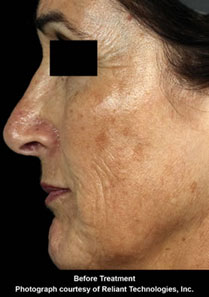
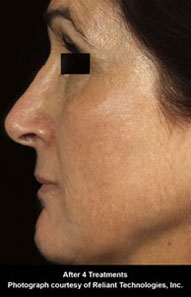
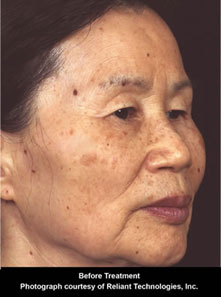
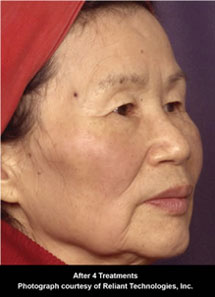
Images courtesy of Reliant Technologies, Inc.
![]()
![]()
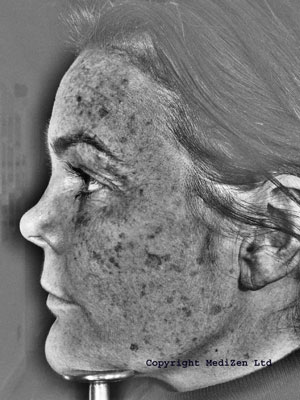
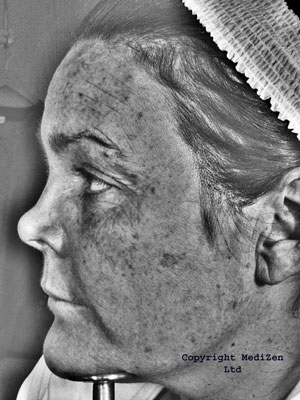
Left pictures: Mottled pigmentation cause by sun damage (black and white picture is taken using a UV camera).
Right pictures: Reduction in pigmentation following just one treatment with PIXEL fractional resurfacing
Images provided courtesy of MediZen Clinics Ltd
All before and after photographs are real patients, your results may differ.
Traditional ablative laser resurfacing has been shown to be very effective in improving deeper lines and wrinkles associated with sun damaged skin. The downside is the recovery time and potential complications.
As a consequence of this, the development of lasers has focussed on non-ablative laser and IPL light sources that do not remove the surface of the skin, but still cause visible improvement of lines and wrinkles. These alternatives do not, as yet, produce such dramatic and long lasting results as ablative lasers, but they are safer and involve virtually no recovery time. Please see our laser/IPL/LHE skin rejuvenation section for more details.
The fractional laser arena can also be divided into fractional ablative and fractional non-ablative devices.
Whilst not 100% as effective as traditional ablative laser procedures, (depending on the depth and severity of the wrinkles being treated), fractional laser skin resurfacing (ablative and non-ablative) appears to achieve comparable skin improvements as obtained with conventional ablative laser skin resurfacing but with fewer potential side effects.
However whether standard ablative or fractional ablative technologies are a clear performance leader is still to be determined. Similarly, the argument for ablative fractional versus non-ablative fractional is heavily contested within the industry. We will watch this space…